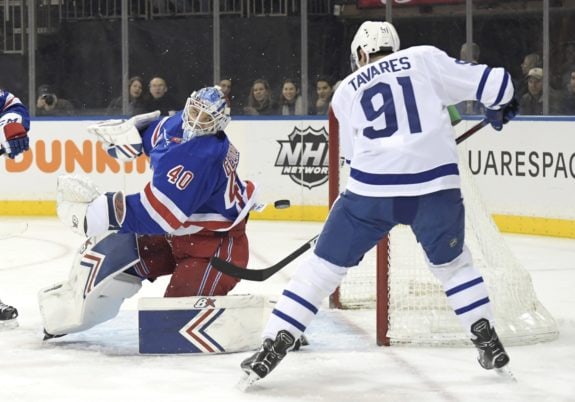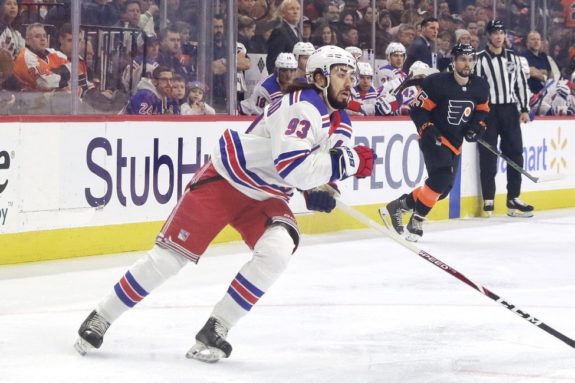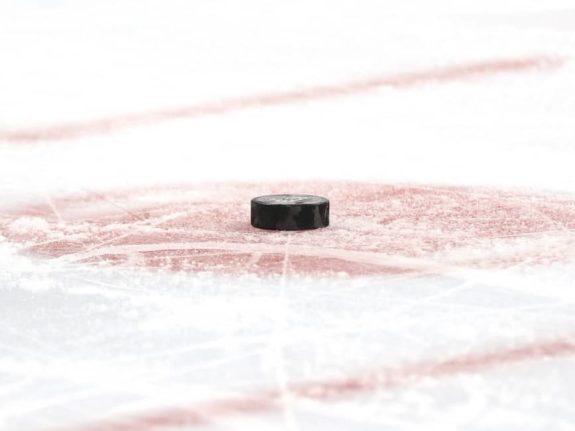It is not a secret that faceoff wins are key in puck possession and pace setting in the NHL. While faceoff wins are important, not every faceoff is a crucial draw. An offensive zone faceoff win is much more important, therefore having a reliable winner is apparent for any successful team.
Surely faceoffs are a very complex event in hockey and the data can provide a limited glimpse about faceoff success. But the New York Rangers have been annually dealing with this area of weakness.
A young team like the Rangers is anticipated to be quite fast; head coach David Quinn joined the team in 2018 with this exact vision in mind. Not only should their speed provide an edge over the competition but they will need to work on mentally dominating their opponents as well. Both physical and mental factors play a role in the game in its entirety but also at a microscopic level — in faceoffs.
A Look at the Numbers
Speed is a determining factor in the faceoff circle. Boston Bruin center Patrice Bergeron is considered one of the best faceoff winners in the league, perhaps one of the best in all of the sport’s history. His size, quickness and intelligence allows for consistent success in the dot.
Last season the veteran ended with a 57.9% success rate on all faceoff attempts. His performance landed him fifth highest in the league with faceoff wins at 759. The Bruins in general are a veteran core of physical players. Season after season, they are a difficult team to beat and this club has the luxury of winning back the puck even if their faceoff taker loses the draw.
Around the league, many clubs have one or two established faceoff takers with consistent winning faceoff records. Last season, centers John Tavares (55.3%) and Auston Matthews (55%) of the Toronto Maple Leafs proved to be once again reliable.

In the Metropolitan Division, Pittsburgh Penguins’ Sidney Crosby (55.6%) and Evgeni Malkin (50.3%) along with Philadelphia Flyers’ Claude Giroux (59%) with Sean Courtier (59.6%) continue to prove the statement. Despite being sent less often to the dot, even former Ranger Kevin Hayes has a 50.2% success rate in Philadelphia.
Related: Young Rangers Look to Avoid Faceoff Disaster
In the upcoming season, the young Rangers organization will need to sort out a lot. For the most part the pieces have been acquired, but now it is the time to make them all work. There shouldn’t be the expectation to advance far this season but rather focus on the internal systems of the team.
Options for the Rangers
For the past few seasons, the Rangers have not had one true, strong faceoff player. The club will need to solidify their designated guy in the future — this is just one of many roles to assign for New York. However, the organization has a few options onboard at the moment to assess.
Center Mika Zibanejad saw 1,204 total draws last season and won 592, leaving him with an averaged 49.2% success rate. He also visited the dot slightly more than fellow center Ryan Strome despite having fewer game appearances. He ended 19th overall in the league for faceoff wins last season, also designated as the Ranger who frequented the dot most often.
The previous season, Zibanejad prevailed in 49.7% of his 1,673 trials. At the conclusion of that season, his numbers bumped him up to the 11th spot overall for wins alone. During the 2017-18 season he won 50.8% of his 1,287 draws.

While his percentage is certainly commendable and factoring in his absence from injury, it would be ideal that the Rangers possess at minimum one forward to win half or over half of his draws. (from ‘Mika Zibanejad misses 13th straight game for Rangers, but return is near,’ Newsday, 11/25/2019)
Of course, more goes into team success than how many dominating faceoff winners a team owns. But the advantage of winning faceoffs allows for formations to be set in the offensive zone and limiting the chances the opponent has with the puck.
It should be noted that Zibanejad’s total appearances in the dot ranked highly, which translates to the Rangers frequently finding themselves on the faceoff. With an increased number of chances to gain possession, it would obviously be in their favor to continue to allow Zibanejad to refine his skills.
With Strome recently extended for another two seasons, he could be up for the role again as well. In his 70 games last season, he won 47.5% of his attempts in just over 1,000 draws. Even though he did not spend the entirety of the 2018-19 season with New York, he saw about 300 fewer draws and collected a 47.6% success rate with his former team, the Edmonton Oilers.
Related: Strome Seeking Longer-Term Role with Rangers
With teams — especially those in the same division — having several options to win a draw, it is definitely a part of the game worth investing in for the Rangers. The team’s top two options in Zibanejad and Strome have resulted in a gap between the third in line to take faceoffs.
The young Brett Howden took only 521 faceoffs and won less than half, leaving him at 48.2% wins in the circle last season. Under Zibanejad and Strome, Howden is sent third most often for the draw. While none of these players are particularly big-bodied, physical players, they are managing despite such gifts.
Importance of the Faceoff Win
Again, faceoffs are not all about physicality, but the ability to be quick-thinking and calculating. Being able to predict what the player across the dot is going to do but also being unpredictable at the same time is one of the many arts of the sport.
The Rangers are in a unique position. They have a star presence found in their older players and they have a lot of flexibility found in their prospect pool. This distinctive era of Rangers hockey could even allow the club to “build” their future faceoff man.

A team without faceoff success will not be sustainable in the long term. The Rangers have a few grittier centers in their pipeline who could develop a strong dot presence. However, other teams will have a wealth of options as well. Reassuringly, as the Rangers have seen in the past, Hayes was able to grown into that role over time before he was ultimately dealt.
Faceoffs can be a less noticeable piece to the game overall but a Stanley Cup contention team will need to excel in all areas of the sport. Either way the organization goes, having strong faceoff success will feed into the confidence, pace and even luck of the Rangers’ game.